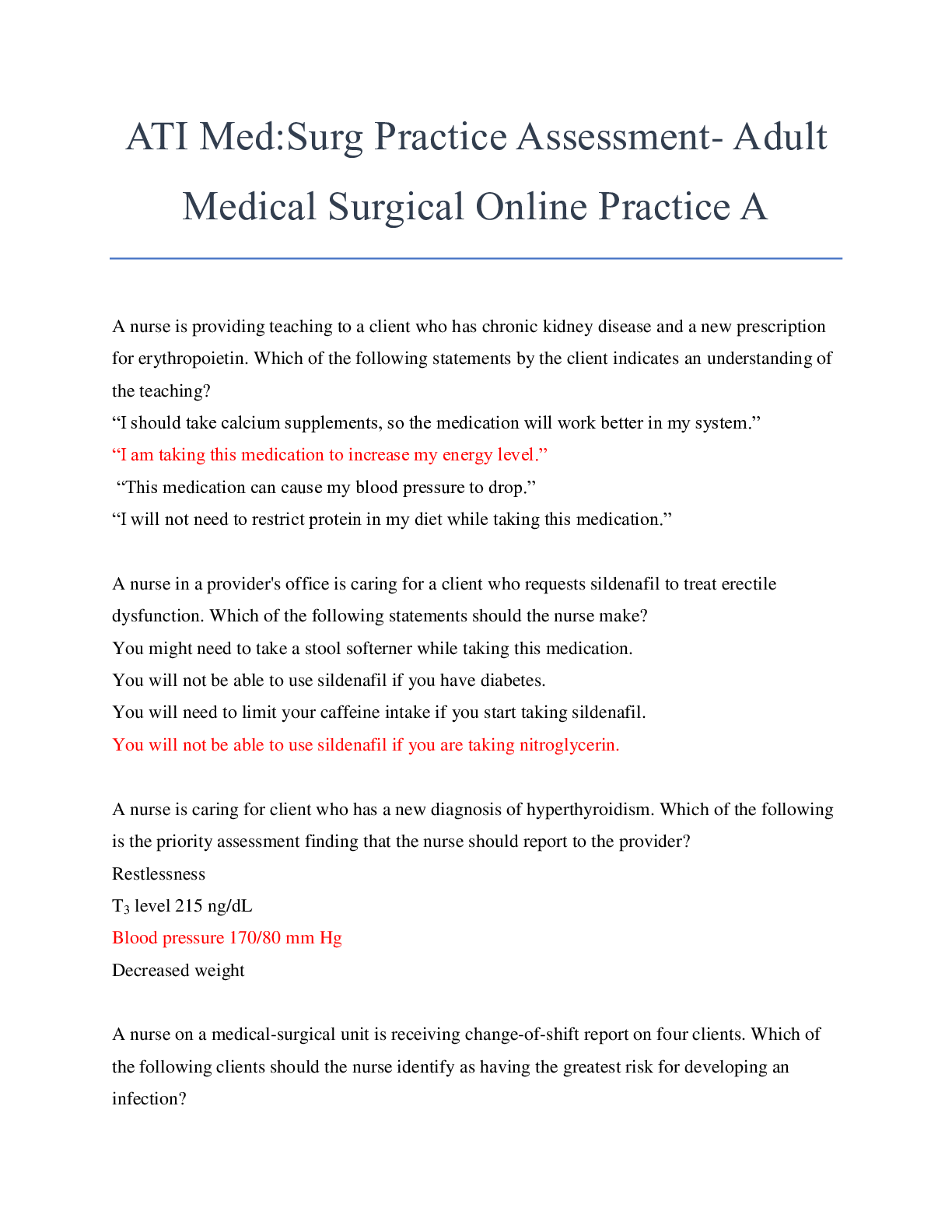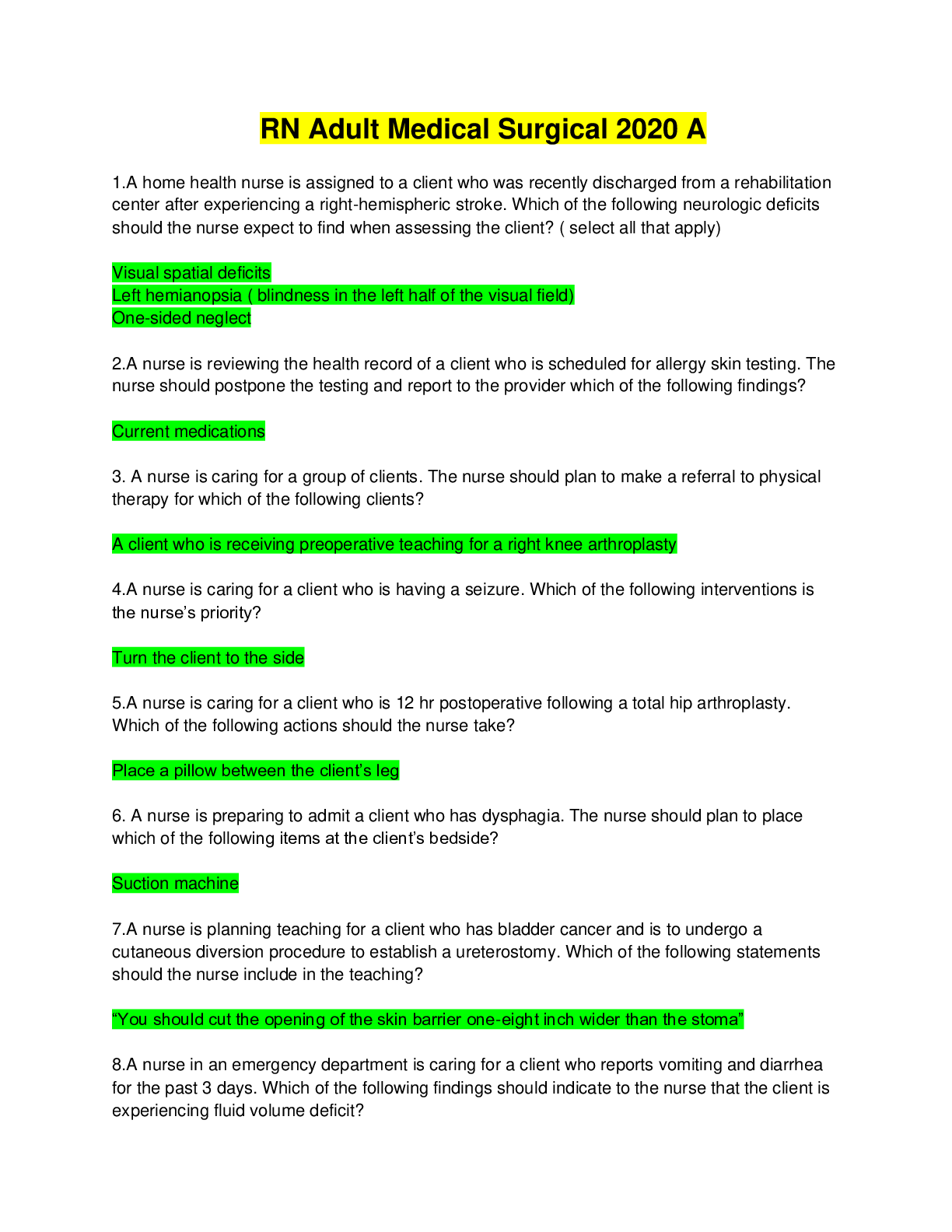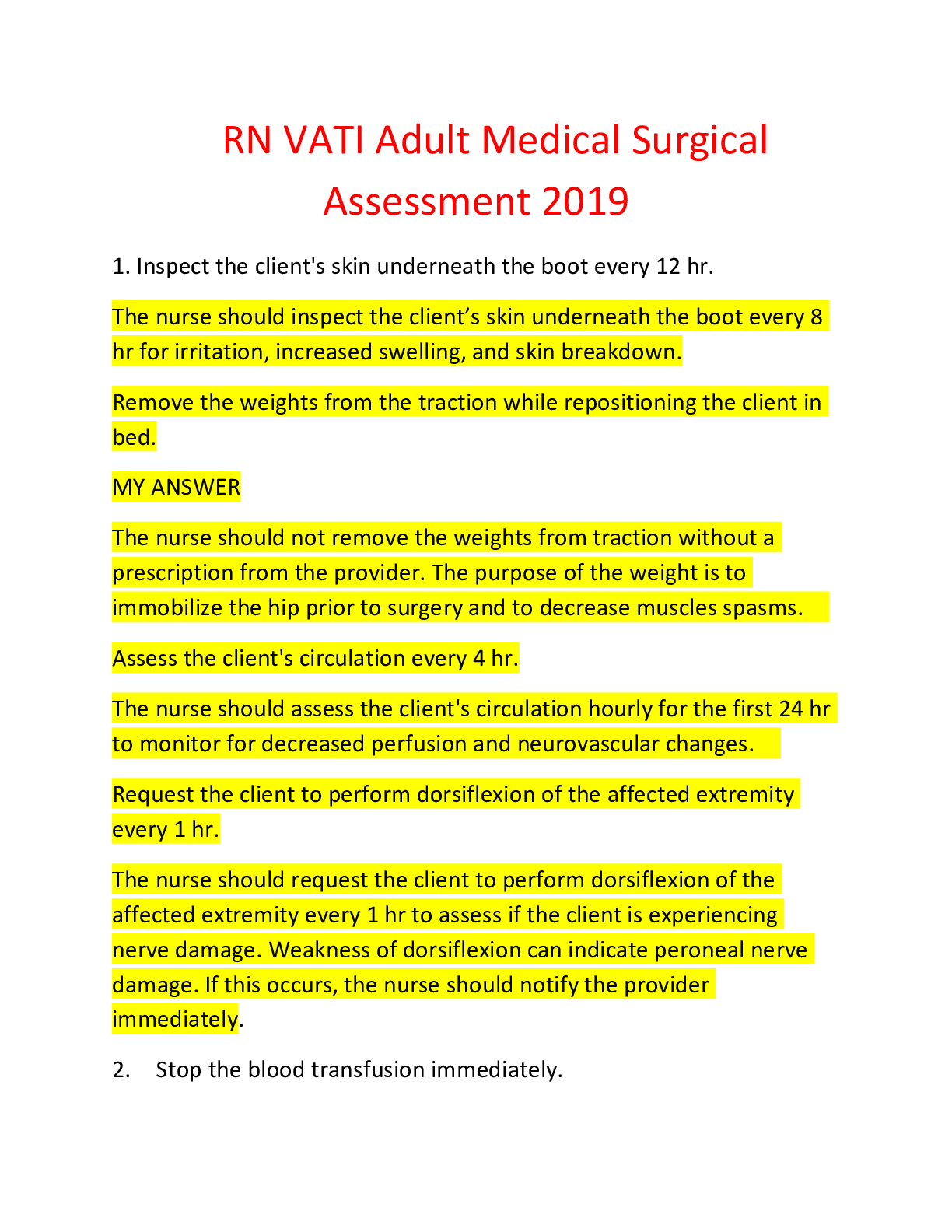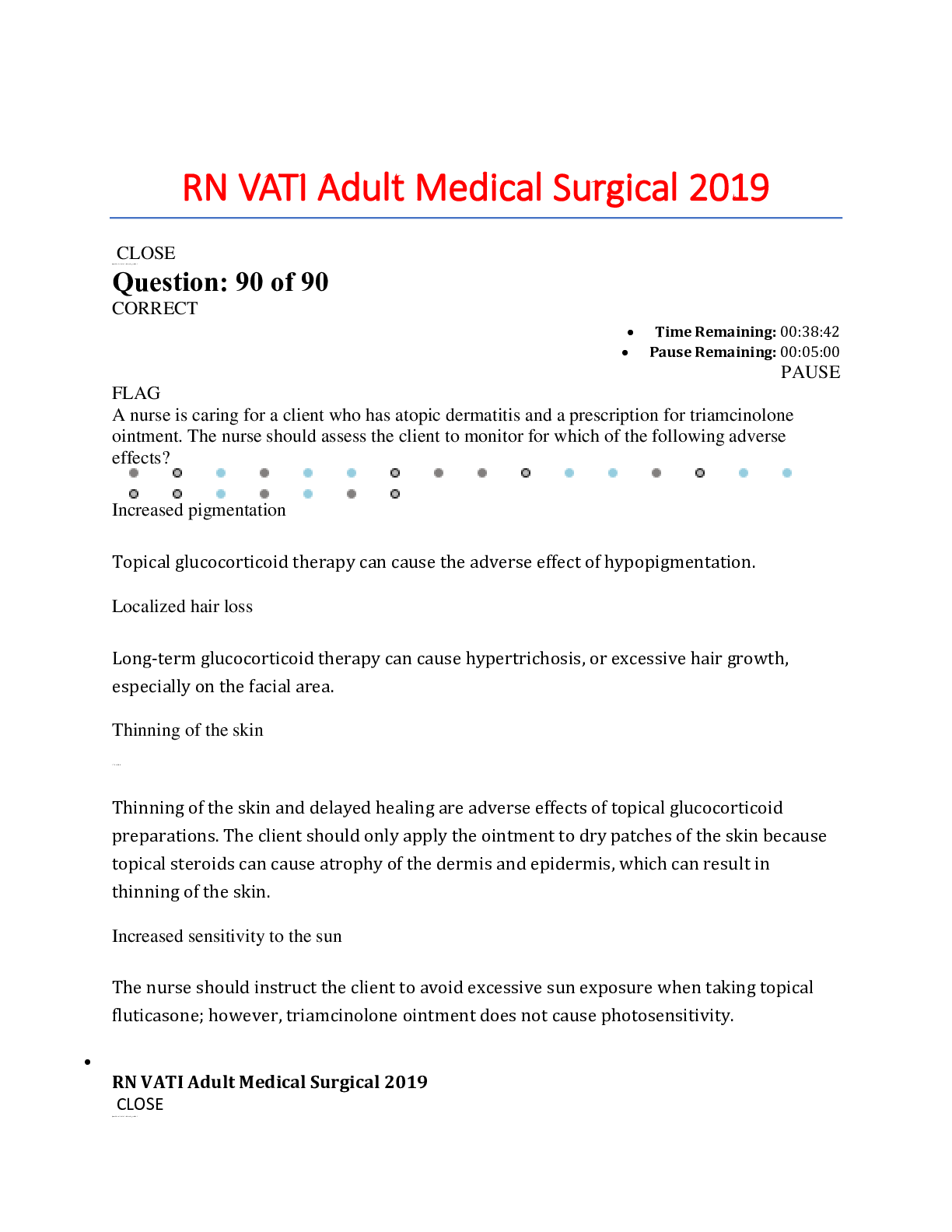*NURSING > EXAM > MED SURG 450 RN VATI Adult Medical Surgical 2020 | MED SURG450 RN VATI Adult Medical Surgical - Moha (All)
MED SURG 450 RN VATI Adult Medical Surgical 2020 | MED SURG450 RN VATI Adult Medical Surgical - Mohave Community college2020
Document Content and Description Below
MED SURG 450 RN VATI Adult Medical Surgical 2020 | MED SURG450 RN VATI Adult Medical Surgical - Mohave Community college2020 • RN VATI Adult Medical Surgical 2019 CLOSE Question 90 loaded ratio... nals provided Question: 90 of 90 CORRECT • Time Remaining: 00:38:42 • Pause Remaining: 00:05:00 PAUSE FLAG A nurse is caring for a client who has atopic dermatitis and a prescription for triamcinolone ointment. The nurse should assess the client to monitor for which of the following adverse effects? Top of Form Increased pigmentation Topical glucocorticoid therapy can cause the adverse effect of hypopigmentation. Localized hair loss Long-term glucocorticoid therapy can cause hypertrichosis, or excessive hair growth, especially on the facial area. Thinning of the skin MY ANSWER Thinning of the skin and delayed healing are adverse effects of topical glucocorticoid preparations. The client should only apply the ointment to dry patches of the skin because topical steroids can cause atrophy of the dermis and epidermis, which can result in thinning of the skin. Increased sensitivity to the sun The nurse should instruct the client to avoid excessive sun exposure when taking topical fluticasone; however, triamcinolone ointment does not cause photosensitivity. • RN VATI Adult Medical Surgical 2019 CLOSE Question 89 loaded rationals provided Question: 89 of 90 CORRECT • Time Remaining: 00:37:45 • Pause Remaining: 00:05:00 PAUSE FLAG A nurse is assessing a client who has left-sided heart failure. Which of the following findings should the nurse identify as a manifestation of left-sided heart failure? Top of Form Dependent edema The nurse should identify that dependent edema is a manifestation of right-sided heart failure due to right ventricular failure and fluid retention from pressure building up in the venous system. Jugular distention The nurse should identify that jugular vein distention is a manifestation of right-sided heart failure due to right ventricular failure and fluid retention from pressure building up in the venous system. Weight gain The nurse should identify that weight gain is a manifestation of right-sided heart failure due to right ventricular failure and fluid retention from pressure building up in the venous system. Frothy sputum MY ANSWER The nurse should identify that frothy sputum, dyspnea, and wheezing are manifestations of left-sided heart failure. Treatment includes fluid restriction and diuretics to decrease preload and reduce pulmonary congestion. Pink-tinged frothy sputum can be an early indication of pulmonary edema and can be life-threatening. Therefore, the nurse should notify the provider immediately. Bottom of Form • RN VATI Adult Medical Surgical 2019 CLOSE Question 88 loaded rationals provided Question: 88 of 90 CORRECT • Time Remaining: 00:37:30 • Pause Remaining: 00:05:00 PAUSE FLAG A nurse is caring for a client who is experiencing anxiety as well as numbness and tingling of the lips and fingers. The client's ABGs are: pH 7.48, PCO2 30 mm Hg, HCO3- 24 mEq/L, PaO2 85 mm Hg. Which of the following acid-base imbalances should the nurse identify that the client is experiencing? Top of Form Respiratory alkalosis MY ANSWER This pH is alkaline (increased) and the PCO2 is decreased, representing alveolar hyperventilation and resultant respiratory alkalosis. Respiratory acidosis This pH is alkaline (increased) and the PCO2 is decreased. A decreased pH and an increased PCO2 indicate respiratory acidosis. Metabolic alkalosis This HCO3- 24 mEq/L is within the expected range of 21 to 28 mEq/L and the pH is alkaline (increased). An increased pH and HCO3- indicate metabolic alkalosis. Metabolic acidosis This HCO3- 24 mEq/L is within the expected range of 21 to 28 mEq/L and the pH is alkaline (increased). A decreased pH and HCO3- indicate metabolic acidosis. Bottom of Form • RN VATI Adult Medical Surgical 2019 CLOSE Question 87 loaded rationals provided Question: 87 of 90 CORRECT • Time Remaining: 00:37:22 • Pause Remaining: 00:05:00 PAUSE FLAG A nurse is assessing a client who has Cushing's syndrome. Which of the following findings should the nurse expect? Top of Form Vitiligo Vitiligo is the loss of pigment from areas of a client's skin, causing irregular, white patches. Vitiligo is a manifestation of adrenal-gland hypofunction. Osteoporosis MY ANSWER Osteoporosis is a common finding with Cushing's syndrome. Bones become thinner as a result of mineral loss and nitrogen depletion, and the risk for fractures increases. Myxedema A client who has hypothyroidism can develop myxedema that causes mucinous cellular edema around the eyes, across the upper back, and in the hands and feet. Heat intolerance A client who has hyperthyroidism can develop heat intolerance, along with an increase in sweating. Bottom of Form • RN VATI Adult Medical Surgical 2019 CLOSE Question 86 loaded rationals provided Question: 86 of 90 CORRECT • Time Remaining: 00:37:13 • Pause Remaining: 00:05:00 PAUSE FLAG A nurse is inspecting the skin of a client who has basal cell carcinoma. The nurse should identify which of the following lesion characteristics on the client's skin? Top of Form A pearly, waxy nodule MY ANSWER A client who has basal cell carcinoma has a nodular lesion with well-defined borders and a pearly or waxy appearance, resulting from overexposure to the sun, especially on the face, head, and neck. An irregular border on a variegated-colored lesion A client who has melanoma has a lesion with irregular borders and variegated colors of red, white, and blue, most often on the upper back or lower legs. A firm, nodular, crusty, or ulcerated lesion A client who has squamous cell carcinoma has a firm, nodular, and crusty lesion with an ulcerated center, resulting from sun exposure, chronic irritation, burns, or irradiation to the skin. A weeping vesicle A client who has herpes zoster has weeping, blister-type lesions. Bottom of Form • RN VATI Adult Medical Surgical 2019 CLOSE Question 85 loaded rationals provided Question: 85 of 90 CORRECT • Time Remaining: 00:37:02 • Pause Remaining: 00:05:00 PAUSE FLAG A nurse is assessing a client who has hypocalcemia. In which of the following areas should the nurse tap on the client's face to detect the presence of Chvostek's sign? (You will find hot spots to select in the artwork below. Select only the hot spot that corresponds to your answer.) Top of Form A is correct. The nurse should tap the client's cheek just in front of the ear and below the zygomatic arch. The client who has hypocalcemia will display a Chvostek's sign, which is a twitching of the facial muscle. B is incorrect. The nurse should apply upward pressure at the supraorbital ridge, below the eyebrow, to assess for tenderness and inflammation of the frontal sinuses. C is incorrect. The nurse should palpate the jaw and mastoid muscle of a client who has temporomandibular joint dysfunction. This can be caused by misaligned teeth, arthritis, or grinding of the teeth. With palpation, the nurse might feel a click, pop, or grating sensation when the client opens or closes the jaw. Bottom of Form • RN VATI Adult Medical Surgical 2019 CLOSE Question 84 loaded rationals provided Question: 84 of 90 CORRECT • Time Remaining: 00:36:55 • Pause Remaining: 00:05:00 PAUSE FLAG A nurse in an emergency department is assessing a client who is overusing prescribed diuretics and has a sodium level of 127 mEq/L. Which of the following laboratory findings should the nurse expect? Top of Form High lipase A high lipase level is associated with pancreatic dysfunction or renal failure and is not an expected finding with hyponatremia or dehydration. Low urine specific gravity MY ANSWER A client who has hyponatremia as a result of diuretic overuse has a low urine specific gravity. The increased excretion of water alters the ratio of particulate matter, which affects the specific gravity. Low hemoglobin A client who is dehydrated as a result of diuretic overuse can have an elevated hemoglobin level because of the difference in ratio between intravascular fluid and blood cells. High creatine kinase-MB (CK-MB) An elevated CK-MB level indicates a myocardial infarction and is not an expected finding with hyponatremia. Bottom of Form • RN VATI Adult Medical Surgical 2019 CLOSE Question 83 loaded rationals provided Question: 83 of 90 INCORRECT • Time Remaining: 00:36:47 • Pause Remaining: 00:05:00 PAUSE FLAG A home health nurse is assisting a client with planning care for a family member who has Alzheimer's disease. Which of the following instructions should the nurse include? Top of Form Remove clutter from rooms and hallways. The nurse should instruct the family member to remove clutter from rooms and hallways so the client is able to walk without the risk of falling or tripping over objects. Later in the disease, the client can experience seizures, so cluttered areas could be a risk to the client. Place a monthly calendar in the client's room. MY ANSWER The nurse should instruct the family member to place a single-date calendar in the client's room. A monthly calendar can be overwhelming and confusing to a client who has Alzheimer's disease. Use confrontation to manage the client's behavior. The nurse should instruct the family member to redirect the client by starting another activity when the client begins to act out or becomes overstimulated. Redirecting the client might help them gain focus. Review the daily schedule with the client every morning. The nurse should instruct the family member to use short, simple sentences when explaining an activity to the client. The explanation should be done immediately before the activity to aid the client's memory and ability to follow directions. Bottom of Form • RN VATI Adult Medical Surgical 2019 CLOSE Question 82 loaded rationals provided Question: 82 of 90 CORRECT • Time Remaining: 00:36:39 • Pause Remaining: 00:05:00 PAUSE FLAG A nurse is caring for a client who has developed acute respiratory distress syndrome (ARDS). Which of the following findings should the nurse identify as a manifestation of this syndrome? Top of Form An audible pleural friction rub A client who has a pulmonary embolism can have a pleural friction rub along with tachypnea, tachycardia, dyspnea, and sudden, sharp chest pain. However, a pleural friction rub is not a manifestation of ARDS. Tracheal deviation from the midline A client who has a tension pneumothorax can have tracheal deviation with dyspnea, tachycardia, and tachypnea. On auscultation, breath sounds over the area of the pneumothorax are decreased or absent. However, tracheal deviation is not a manifestation of ARDS. Refractory hypoxemia MY ANSWER ARDS is a systemic inflammatory response to trauma, sepsis, burns, pancreatitis, and blood transfusions, when excess lung fluid dilutes surfactant activity in the lungs. A client who has ARDS has refractory hypoxemia, which is hypoxemia that does not improve with oxygen therapy. Extensive pulmonary edema evident on a chest x-ray is a manifestation of ARDS. Bloody expectorant when coughing A client who has lung cancer or laryngeal trauma can have hemoptysis. However, bloody expectorant is not a manifestation of ARDS. Bottom of Form • RN VATI Adult Medical Surgical 2019 CLOSE Question 81 loaded rationals provided Question: 81 of 90 CORRECT • Time Remaining: 00:36:33 • Pause Remaining: 00:05:00 PAUSE FLAG An emergency room nurse is assessing a client who has asthma and difficulty breathing. Which of the following findings should indicate to the nurse that the client is experiencing status asthmaticus? Top of Form Coughing Status asthmaticus causes labored breathing and wheezing. Coughing indicates that the client is exchanging air and is a manifestation of pneumonia, not status asthmaticus. Flat neck veins A client who has status asthmaticus has distended neck veins while trying to facilitate breathing due to increased pulmonary pressure. Use of accessory muscles MY ANSWER A client who has status asthmaticus uses accessory muscles to help facilitate breathing, which is a manifestation of a severe airflow obstruction. The situation is life-threatening and the nurse should intervene immediately with strong systemic bronchodilators, epinephrine, corticosteroids, and oxygen. Presence of coarse crackles The presence of coarse crackles indicates air movement through fluid-filled airways and is a manifestation of pneumonia, not status asthmaticus. Bottom of Form • RN VATI Adult Medical Surgical 2019 CLOSE Question 80 loaded rationals provided Question: 80 of 90 CORRECT • Time Remaining: 00:36:27 • Pause Remaining: 00:05:00 PAUSE FLAG A nurse is teaching a client who has a new prescription for phenytoin to treat a seizure disorder. Which of the following adverse effects should the nurse instruct the client to report immediately to the provider? Top of Form Tender, bleeding gums Gingival hyperplasia is an overgrowth of gum tissue that causes the gums to bleed, swell, and become tender. Gingival hyperplasia is nonurgent adverse effect when a client is taking phenytoin; therefore, there is another finding that is the priority. The nurse should advise the client to maintain good oral hygiene with a soft toothbrush and to follow up with an oral health professional. Increased facial hair Hirsutism, an increased growth of hair in unexpected places on the client's body, is nonurgent because it is an expected finding for a client who is taking phenytoin. Constipation Constipation is nonurgent because it is an expected finding for a client who is taking phenytoin. Skin rash MY ANSWER When using the urgent vs. nonurgent approach to client care, the nurse should determine that the priority finding is a rash, which can have a measles-like appearance and progress to exfoliative dermatitis or Stevens-Johnson syndrome. The client should report this finding to the provider immediately. Bottom of Form • RN VATI Adult Medical Surgical 2019 CLOSE Question 79 loaded rationals provided Question: 79 of 90 INCORRECT • Time Remaining: 00:36:21 • Pause Remaining: 00:05:00 PAUSE FLAG A nurse is monitoring a client following a lumbar laminectomy. The client has a drain and indwelling urinary catheter. The nurse should identify which of the following findings as an indication of a complication of the surgery? Top of Form Oral temperature of 37.2° C (99° F) The nurse should expect a slight elevation of the client's temperature postoperatively. However, an increased temperature elevation or a spike can indicate an infection. Clear drainage on the dressings The nurse should identify clear drainage on or around the dressing as an indication of a cerebral spinal leak and should report this finding to the provider immediately. Drain output 75 mL in 4 hr The nurse should expect the client to have no more than 125 mL of drain output in 4 hr. Decreased bowel sounds in all quadrants of the abdomen MY ANSWER The nurse should expect decreased bowel sounds when caring for a client following a laminectomy due to anesthesia and pain medication. The nurse should continue to monitor the client to assess for a paralytic ileus. Bottom of Form • RN VATI Adult Medical Surgical 2019 CLOSE Question 78 loaded rationals provided Question: 78 of 90 CORRECT • Time Remaining: 00:36:15 • Pause Remaining: 00:05:00 PAUSE FLAG A nurse is assessing a client who has right-sided heart failure. Which of the following findings should the nurse identify as a manifestation of right-sided heart failure? Top of Form S3 gallop An S3/S4 summation gallop is an expected finding with left-sided heart failure due to pulmonary congestion and increased left ventricular pressure that causes a decrease in cardiac output and poor tissue perfusion. Weak peripheral pulses Weak peripheral pulses are an expected finding with left-sided heart failure due to decreased cardiac output. Increased abdominal girth MY ANSWER Increased abdominal girth is an expected finding with right-sided heart failure due to systemic congestion and an enlarged liver and spleen. Systemic congestion can lead to fluid retention and increased pressure in the venous system, which can manifest with edema in the lower extremities. Wheezing Wheezing is an expected finding with left-sided heart failure due to pulmonary congestion and systolic dysfunction. Bottom of Form • RN VATI Adult Medical Surgical 2019 CLOSE Question 77 loaded rationals provided Question: 77 of 90 INCORRECT • Time Remaining: 00:36:06 • Pause Remaining: 00:05:00 PAUSE FLAG A nurse is caring for a client who recently assumed the role of caregiver for their aging parents who have chronic illnesses. The nurse should identify that which of the following statements by the client indicates acceptance of the role change? Top of Form "I changed the floor plan of our home to accommodate my father's wheelchair." The nurse should identify that the client has accepted the role change of caring for their aging parents by changing the floor plan of the home to accommodate their father's wheelchair. "I'm so stressed out that it makes it difficult for me to manage everything." This response indicates role overload because the client is feeling overwhelmed with having to care for their aging parents. "At times, I get so frustrated with how to care for my parents." This response indicates role strain, in which the client feels unsure and frustrated about caring for their aging parents. Feelings of inadequacy can also occur with role strain. "I am learning to take care of my parents as I go." MY ANSWER This response indicates role ambiguity, in which the client feels unsure about how to care for their aging parents. This might create stress for the client. Bottom of Form • RN VATI Adult Medical Surgical 2019 CLOSE Question 76 loaded rationals provided Question: 76 of 90 CORRECT • Time Remaining: 00:36:00 • Pause Remaining: 00:05:00 PAUSE FLAG A nurse is caring for a client who is receiving vancomycin intermittent IV bolus therapy for methicillin-resistant Staphylococcus aureus (MRSA). Which of the following findings is an indication to the nurse that the client is experiencing an adverse effect of the medication? Top of Form The client's blood pressure is elevated. The client can have an adverse effect called red man syndrome, which causes hypotension and tachycardia, due to infusing the vancomycin too rapidly. The nurse should infuse the medication over at least 60 min. The client is becoming flushed. MY ANSWER Flushing is a manifestation of an infusion reaction to vancomycin that also causes a rash on the face and upper body, called red man syndrome. Red man syndrome results from infusing vancomycin too rapidly. The nurse should infuse the medication over at least 60 min. The client reports blurred vision. Blurred vision is not a manifestation of an infusion reaction to vancomycin. Vancomycin can have sensory implications, however. Although rare, it can cause ototoxicity, which is generally reversible. The client is experiencing polyuria. Polyuria is not a manifestation of an infusion reaction to vancomycin. However, vancomycin can cause renal failure. Bottom of Form • RN VATI Adult Medical Surgical 2019 CLOSE Question 75 loaded rationals provided Question: 75 of 90 CORRECT • Time Remaining: 00:35:54 • Pause Remaining: 00:05:00 PAUSE FLAG A nurse is caring for a male client who has a new prescription for cyclosporine following a kidney transplant. Which of the following findings should the nurse identify as an adverse effect of this therapy? Top of Form WBC count 8,000/mm3 A WBC count of 8,000/mm<sup3< sup=""> is within the expected reference range of 5,000 to 10,000/mm3. If the client develops leukopenia, the nurse should notify the provider because the client is at risk for infection when taking an immunosuppressant such as cyclosporine.</sup3<> RBC count 6 million/mm3 An RBC count of 6 million/mm3 is within the expected reference range of 4.7 to 6.1 million/mm3 for men and 4.2 to 5.4 million/m3 for women. If the client's RBC count decreases, the nurse should notify the provider because the client is at risk for bleeding following an organ transplant. BUN 24 mg/dL MY ANSWER A BUN of 24 mg/dL is above the expected reference range of 10 to 20 mg/dL, indicating renal impairment. An adverse effect of cyclosporine is nephrotoxicity. The nurse should monitor the client for increases in BUN and creatinine and report any elevation to the provider. A rise in BUN could indicate transplant rejection. Potassium 3.5 mEq/L A potassium level of 3.5 mEq/L is within the expected reference range of 3.5 to 5 mEq/L and does not indicate nephrotoxicity. However, the nurse should report a dramatic change in potassium level to the provider. Bottom of Form • RN VATI Adult Medical Surgical 2019 CLOSE Question 74 loaded rationals provided Question: 74 of 90 CORRECT • Time Remaining: 00:35:49 • Pause Remaining: 00:05:00 PAUSE FLAG A nurse is caring for a client who has dumping syndrome following a gastric resection. The nurse should monitor the client for which of the following complications of dumping syndrome? Top of Form Weight gain Anorexia can result from dumping syndrome because the client can easily become reluctant to eat to avoid the unpleasant manifestations of this syndrome, resulting in weight loss. Iron-deficiency anemia MY ANSWER The nurse should monitor the client for manifestations of anemia, such as pallor, tachycardia, and fatigue. Rapid emptying of the stomach contents into the intestine can lead to reduced absorption of iron in the duodenum, causing iron-deficiency anemia. Hypercalcemia Hypocalcemia, rather than hypercalcemia, is a manifestation of dumping syndrome due to rapid gastric emptying. Reduced heart rate Nausea, abdominal cramping, and tachycardia are manifestations of dumping syndrome due to rapid gastric emptying. Bottom of Form • RN VATI Adult Medical Surgical 2019 CLOSE Question 73 loaded rationals provided Question: 73 of 90 INCORRECT • Time Remaining: 00:35:43 • Pause Remaining: 00:05:00 PAUSE FLAG A nurse is assessing a client who takes salmeterol to treat moderate asthma. Which of the following findings should indicate to the nurse that the medication has been effective? Top of Form The client's daily peak expiratory flow (PEF) measures 85% above personal best. A client who has asthma should use a peak flow meter twice daily to monitor asthma control. A PEF in the green zone, or 80% or above personal best, indicates the effectiveness of medication therapy. The client's ABGs shows a pH level of 7.32. A pH level of 7.32 indicates the client is in an acidotic state. Acidosis occurs with bronchoconstriction and indicates the medication has not been effective. The client's forced expiratory volume is decreased after treatment with medication. MY ANSWER Forced expiratory volume measures the amount of air the client exhales during 1 second and is part of pulmonary function testing. Effective use of a bronchodilator should increase the client's forced expiratory volume. The client's wheezing is limited to expiratory. Salmeterol is a long-acting bronchodilator that helps prevent asthma attacks. Wheezing is a narrowing of the airways and indicates that the medication has not been effective. Bottom of Form • RN VATI Adult Medical Surgical 2019 CLOSE Question 72 loaded rationals provided Question: 72 of 90 CORRECT • Time Remaining: 00:35:38 • Pause Remaining: 00:05:00 PAUSE FLAG A nurse is providing teaching about health promotion activities for a client who has a new diagnosis of type 1 diabetes mellitus. Which of the following statements by the client indicates an understanding of the teaching? Top of Form "If I can keep my hemoglobin A1C less than 6.5%, I will be cured of diabetes." Tight control of blood glucose levels can minimize complications associated with diabetes mellitus such as cardiovascular disease, nephropathy, neuropathy, and retinopathy. The nurse should instruct the client that type 1 diabetes mellitus is a chronic condition that causes the body to fail to manufacture insulin and cannot currently be cured. "I will check my blood sugar level before exercising." MY ANSWER Clients who have diabetes mellitus should not exercise if their blood glucose level is less than 80 mg/dL or greater than 250 mg/dL. A client who has type 1 diabetes mellitus and is hyperglycemic can experience even higher blood glucose levels. Hypoglycemia can also occur during exercise and up to 24 hr following exercise. The nurse should instruct the client to monitor blood glucose levels before, during, and following exercise. "I should have my eyes checked every 2 years." Microvascular changes to the vessels in the eyes occurs with elevated blood glucose levels, which can lead to retinopathy. To monitor for changes to the eyes, the client should have eye examinations every year. "I should soak my feet daily in warm, soapy water." Health promotion activities for a client who has diabetes mellitus includes foot care. Clients should inspect their feet and wash them daily with warm water and soap. - - - - - - - - - - - - - - "Practice breath-holding." The nurse should teach the client to use pursed-lip breathing and avoid breath-holding, which can increase the amount of air that is trapped in the lungs. Pursed-lip breathing decreases the amount of stale air in the lungs and decreases dyspnea by forcefully and slowly exhaling through pinched lips, as if to whistle. "Perform arm-reaching exercises." The client should avoid activities involving the arms because this type of activity limits the availability of the accessory muscles essential for ventilation, which results in decreased exercise tolerance. Bottom of Form • RN VATI Adult Medical Surgical 2019 CLOSE Question 3 loaded rationals provided Question: 3 of 90 CORRECT • Time Remaining: 00:28:18 • Pause Remaining: 00:05:00 PAUSE FLAG A nurse is assessing a client's understanding of a surgical procedure prior to witnessing their signature on the informed consent form. The nurse determines that the client does not understand what the procedure will involve. Which of the following actions should the nurse take? Top of Form Provide teaching about the surgical procedure for the client. The responsibility of discussing the surgical procedure, including the risks, benefits, and alternative therapies, belongs to the provider who will be performing the procedure. If the information the nurse gives to the client is incorrect or incomplete, the nurse is liable and might face legal action. Instruct the client's spouse to sign the consent form. Any client who is competent should sign their own surgical consent form. A spouse or guardian can sign the form if the client is incompetent, incapacitated, or a minor. Read the consent form to the client using words the client will understand. The consent form should be read to a client who is unable to read. However, the nurse should recognize that the consent form does not contain all of the educational information regarding the procedure that the provider shared with the client. Therefore, reading the consent form to the client will not increase the client's understanding of the procedure, risks, benefits, and alternative treatments. Contact the provider who will be performing the procedure. MY ANSWER The nurse should advocate for the client by informing the provider if the client does not understand the procedure. It is the responsibility of the provider to discuss the procedure more fully with the client. Bottom of Form • RN VATI Adult Medical Surgical 2019 CLOSE Question 2 loaded rationals provided Question: 2 of 90 CORRECT • Time Remaining: 00:28:11 • Pause Remaining: 00:05:00 PAUSE FLAG A nurse is providing teaching to a client who is scheduled for a bronchoscopy. Which of the following statements should the nurse include in the teaching? Top of Form "You will not be able to eat or drink after the procedure until you are able to cough." MY ANSWER A client who had a bronchoscopy received a local anesthetic that can suppress the cough reflex. The cough reflex protects the client from aspirating fluids or food. Therefore, the client should not eat or drink until the cough reflex returns. "You will drink a contrast solution 30 minutes prior to the procedure." A bronchoscopy allows for direct visualization of bronchial structures and does not require the use of a contrast solution. The client should be NPO for 4 to 8 hr prior to the test. "The purpose of this procedure is to remove excess fluid from your lungs." A bronchoscopy allows for direct visualization of bronchial structures to identify disorders, collect specimens, remove foreign bodies or secretions, stop bleeding, remove lesions, or provide brachytherapy or radiation to the endobronchial area. A thoracoscopy removes excess fluid from the pleural cavity. "You will need to lie on your back for 4 to 6 hours following the procedure." Following a bronchoscopy, the client is at risk for hypoxia and dyspnea. Therefore, the nurse should elevate the head of the client's bed. Bottom of Form • RN VATI Adult Medical Surgical 2019 CLOSE Question 1 loaded rationals provided Question: 1 of 90 CORRECT • Time Remaining: 00:28:06 • Pause Remaining: 00:05:00 PAUSE FLAG A nurse is caring for a client who is 24 hr postoperative following a total hip arthroplasty. Which of the following actions should the nurse take? Top of Form Place the affected leg in external rotation. The nurse should keep the affected extremity in a neutral position to prevent dislocation. Manifestations of a dislocation of the hip include inward rotation of the affected leg, sudden severe pain, and shortening of the surgical extremity. Encourage the client to use the incentive spirometer every shift. The nurse should encourage the client to cough, breathe deeply, and use the incentive spirometer every 2 hr to prevent pneumonia and atelectasis, which is the collapse of alveoli. Atelectasis can lead to poor oxygen exchange and pneumonia. Instruct the client to lean forward when rising from a chair. To prevent dislocation of the hip, the client should not flex the hip more than 90º at any time. Leaning forward when rising from a chair flexes the hip more than 90º. Maintain abduction of the affected extremity. MY ANSWER The nurse should ensure that the affected extremity is in a position of abduction to prevent hip dislocation. The nurse should place an abductor pillow or several pillows between the client's legs to keep the affected extremity in abduction while the client is in bed. [Show More]
Last updated: 1 year ago
Preview 1 out of 116 pages
Instant download
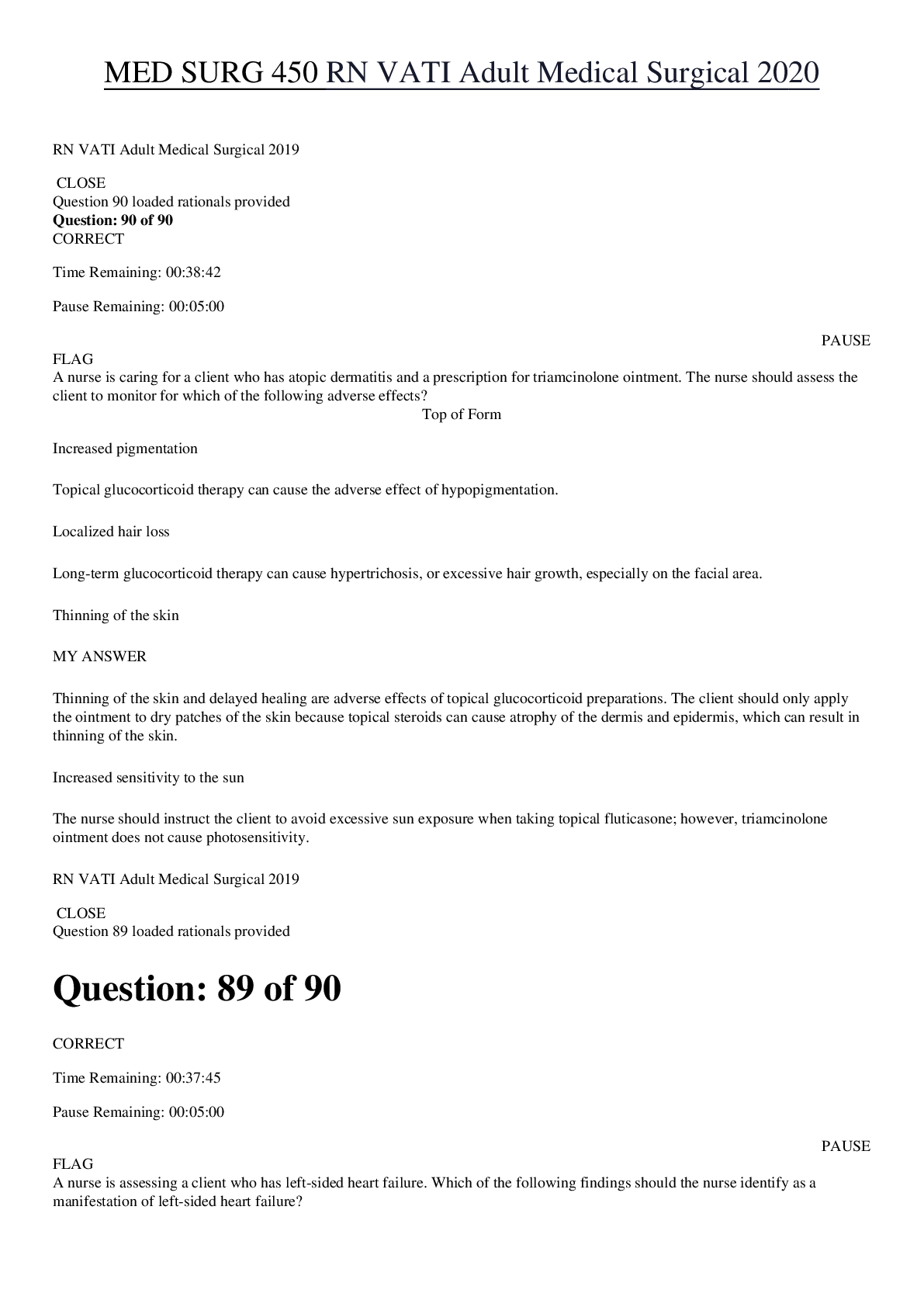
Buy this document to get the full access instantly
Instant Download Access after purchase
Add to cartInstant download
Reviews( 0 )
Document information
Connected school, study & course
About the document
Uploaded On
Jun 13, 2020
Number of pages
116
Written in
Additional information
This document has been written for:
Uploaded
Jun 13, 2020
Downloads
0
Views
76













